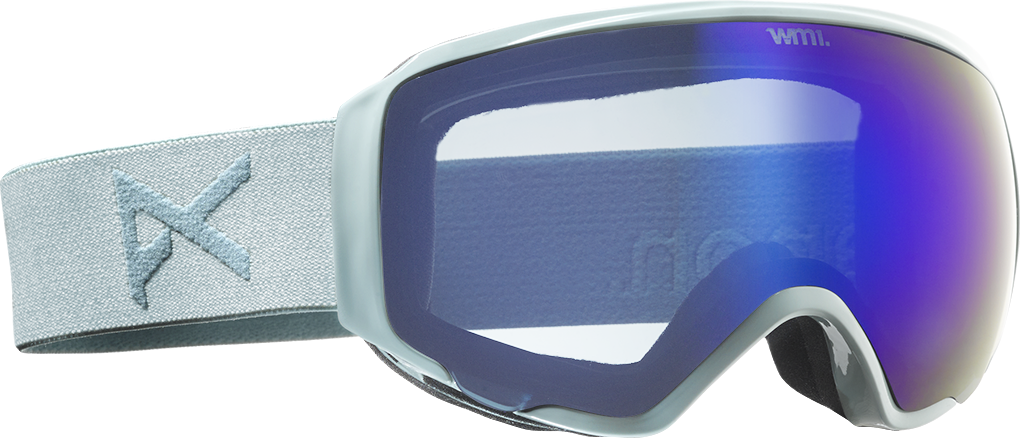
2014-2015 Anon WM1 Goggle
Features:
- Magna-Tech Quick Lens Change Technology
- Spherical Lens Technology
- Wall-to-Wall Vision
- Full Perimeter Channel Venting
- Integral Clarity Technology
- Triple Layer Face Foam
- Lightweight Thermoplastic Polyurethane
- Spare Graybird Lens Included
- Nylon Compression Molded Goggle Case Included
- Microfiber Goggle Bag Included
Fit: Women’s Specific – Frame height 91mm
Frame color: Mint
MSRP: $220
Test Locations: Taos Ski Valley; Alta Ski Area; Crested Butte, Telluride, and Summit County, CO; Bridger Bowl, MT
Days Tested: 20+
Anon set a new standard in the world of goggles with interchangeable lenses last season with their “Magna-Tech” magnetic retention system, which allows you to swap out goggle lenses in just seconds. Will Brown and Jonathan Ellsworth have given high praise to the Anon M1 and larger M2 for featuring the quickest, simplest interchangeable lens system we’ve ever tested and for offering outstanding optics.
For the 2014-2015 season, Anon will be releasing the WM1, which is equipped with the same Magna-Tech technology, but has a slightly smaller frame designed for narrower, female faces. And after testing the WM1 for nearly three weeks already this spring, I’ve found that swapping lenses on the WM1 is also ridiculously simple, and the goggles’ optics are great, too.
Design and Functionality
As with the men’s M1 and M2, removing the lens of the WM1 is really easy, but it does take a moment to get the feel for how it comes off. The lens won’t just pop off any which way—which is a good thing.
There is a small “tab” of lens material on either side of the bottom edge of the lens, and when removing it, it’s best to grab either tab and pull across the face, or grab both tabs and pull straight out. Once I was used to this simple method, I could remove the lens of the WM1 with the goggles still on my face/helmet, with one hand, with my gloves on.
Removing a lens from the WM1 is super easy, but putting a lens back on is even simpler. The men’s M1 has a traditional rimmed design, which means that you do have to check that the lens and its magnets are positioned correctly within the frame (it’s possible to attach the lens to the frame without it being perfectly seated). The M2 has a virtually “rimless” design in that the goggle’s lens is secured on top/in front of the frame, with no frame material flush with the lens. This makes it basically impossible to incorrectly attach a lens to the M2’s frame, and in this sense, the design of the WM1 is more like that of the M2 than the M1.
Though not totally rimless like the M2, as the WM1’s frame’s material does border its lens, there are only two shallow depressions on the frame which the lens “tabs” sit in. In order to drop in a lens, all you have to do is roughly line it up with the frame and the two will snap together. I have tried repeatedly to put the lens in crooked, to see if it would seat incorrectly, and haven’t been able to do so. Even if I line up the lens slightly off-center with the frame, it locks onto the frame perfectly as soon as I let go.
Over the last several seasons, I have mostly used the Smith I/OS goggle, which is the smaller version of the popular Smith I/O. I love the I/OS and found its locking mechanism relatively quick and easy to use. I could change my lenses on the I/OS in a minute or so, but I didn’t end up changing them as nearly as often as I do with the WM1. In short, the ability to change the WM1’s lenses so quickly and easily, without taking off your goggles or gloves, should not be underestimated. It’s super convenient, and a feature I really enjoy having on the hill.
Lens Retention
Anon’s Magna-Tech technology places seven neodymium magnets around the inside of the frame that correspond with the seven magnets on the lens. Each magnet has a pull force of 2.75 pounds, which means the total retention value between the WM1’s lens and frame is 19.25 pounds. This means it should take approximately 75 Gs to dislodge the lens from the frame, though a glancing, shearing blow to the frame could probably unseat the lens with less force.
In any case, in a crash nor any other scenario, I’ve never had the lens of the WM1 accidentally come fully out of the frame. Will Brown had a particularly brutal, high-speed wipeout while wearing the M1 and experienced no issue with its lens retention. The M2 has performed flawlessly in this regard, too.

The only time I had any problem with unwanted disengagement of the WM1’s lens was when I pinched the goggles between the top of the frame and the nosepiece with one hand to pull them over my helmet. Sometimes the lens would partially dislodge for a second, but would always pop in securely once the goggle was on top of my helmet or back on my face. This just meant I had to use both hands to lift the goggles off my face or the front of my helmet.
Fit
I have a pretty small face, and the Smith I/OS fits my face comfortably, but the I/O is way too big for me, so I knew the M1 would be out of the question. The fit of the WM1 is a little bigger than the I/OS, and initially I was concerned it would also be too large for my face. The fit of the WM1 wasn’t too big, though, in fact it’s very comfortable, and I’ve come to prefer it over the I/OS.
The difference in frame size between the I/OS and WM1 goggles is mainly a difference in how tall they are – with a 91mm frame height, the WM1 sits lower on my nose than the I/OS does. The width of the goggles is pretty comparable, and the I/OS actually has a slightly better field of vision than the WM1, probably due to the rimless design of the I/OS. Even so, both goggles allow for very good peripheral vision. By no means is the WM1’s field of view a deal breaker for me.
The I/OS fits perfectly with my Smith Allure helmet, but I had a bit of a goggle gap while wearing the WM1 with it. I had to wear a headband under my helmet on colder days to prevent brainfreeze. As with any pair of goggles, I would recommend trying on the WM1s to see if they fit your face well and be sure to test the goggles’ fit with your helmet, too.
My only gripe with the WM1 is that, unlike the I/OS, there is no sticky silicone on the inside of the goggle strap. While a helmet clip held the goggles in place well enough, they slid around on my helmet a bit more than I would have liked.

are the WM1 goggles compatible with prescription eye glasses?